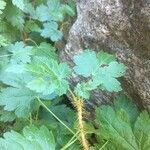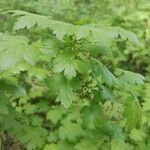Plants 1-3 m. Stems erect to sprawling, glabrous or sparsely retrorse-bristly when young and with black, sessile glands; spines at nodes sometimes absent or 1(-3), 1-8(-12) mm; prickles on internodes usually absent. Leaves: petiole (0.4-)1-5.5 cm, tomentose to pilose, with few longer, slender, stipitate-glandular hairs; blade broadly ovate or pentagonal, 3-5-lobed, cleft nearly 1/2 to midrib, sometimes lateral lobes again less deeply cut into larger distal and smaller proximal segments, 1.5-8 cm, base rounded to broadly cordate, surfaces glabrous, sparsely pubescent, or pilose-villous, usually ciliate, lobes acutish or oblong-rounded, margins deeply crenate-serrate or coarsely round-toothed, apex acute or rounded. Inflorescences pendent, solitary flowers or 2-5-flowered racemes, 1.5-3.5 cm, axis glabrous, flowers evenly spaced. Pedicels not jointed, (1.5-)2.3-5.5(-8) mm, glabrous; bracts ovate, 1-3 mm, glandular-ciliolate. Flowers: hypanthium green or greenish white, narrowly tubular to tubular-campanulate, 1.5-3.5 mm, glabrous or densely pilose to arachnoid-pubescent adaxially; sepals not overlapping, spreading to curved-reflexed (extended in fruit), white or greenish to purplish or reddish margined or tinged, oblong or oblong-lanceolate to narrowly lanceolate, 2.5-5 mm; petals connivent, erect, whitish or pinkish, broadly cuneate-obovate or cuneate-flabellate to cuneate or oblong, not conspicuously revolute or inrolled, 1-2.3 mm; nectary disc not prominent; stamens nearly 2 times as long as petals; filaments linear, 1.8-3.1 mm, mostly glabrous; anthers cream, ovate, 0.6-1.1 mm, apex with cup-shaped gland; ovary glabrous; styles connate 1/3-3/4 their lengths, 4.5-7 mm, proximally pilose-villous to middle or throughout. Berries palatable, greenish or reddish purple to gray-black, nearly globose or globose, 7-11 mm, glabrous. 2n = 16.
More
A shrub. It grows 0.9-1.8 m high and spreads 1.5 m wide. It loses its leaves during the year. The plant has some thorns. The leaves are small and have 3-5 lobes. They have blunt teeth along the edge. The flowers are greenish with pink or white petals. They are in small clusters. The fruit are purple-red and edible.
Stream banks, thickets, open or wooded mountain ridges; at elevations from 700-3,300 metres. Moist, often shaded places; at elevations from 1,000-3,200 metres in California.
More
It is a warm temperate plant. In Canada it grows in foothills and mountain forest. It suits hardiness zones 8-11.


